| View previous topic :: View next topic |
| Author |
Message |
alex ph

Joined: 16 Mar 2013
Posts: 1674
|
 Posted: Sun Jan 20, 2019 1:23 pm Post subject: Minolta Rokkor-PG 1.4/50: Sony A7 vs. Nex-5N Posted: Sun Jan 20, 2019 1:23 pm Post subject: Minolta Rokkor-PG 1.4/50: Sony A7 vs. Nex-5N |
 |
|
alex ph wrote:
Having finally acquired an A7, I am very much pleased with the new capacity the FF offers. In some cases it seems to largely supersede the 10 years-old NEX in line clarity and colour rendition.
Something of the kind, under a nice sun (with Hexanon 1.7/50), after the colours have been boosted a bit more:
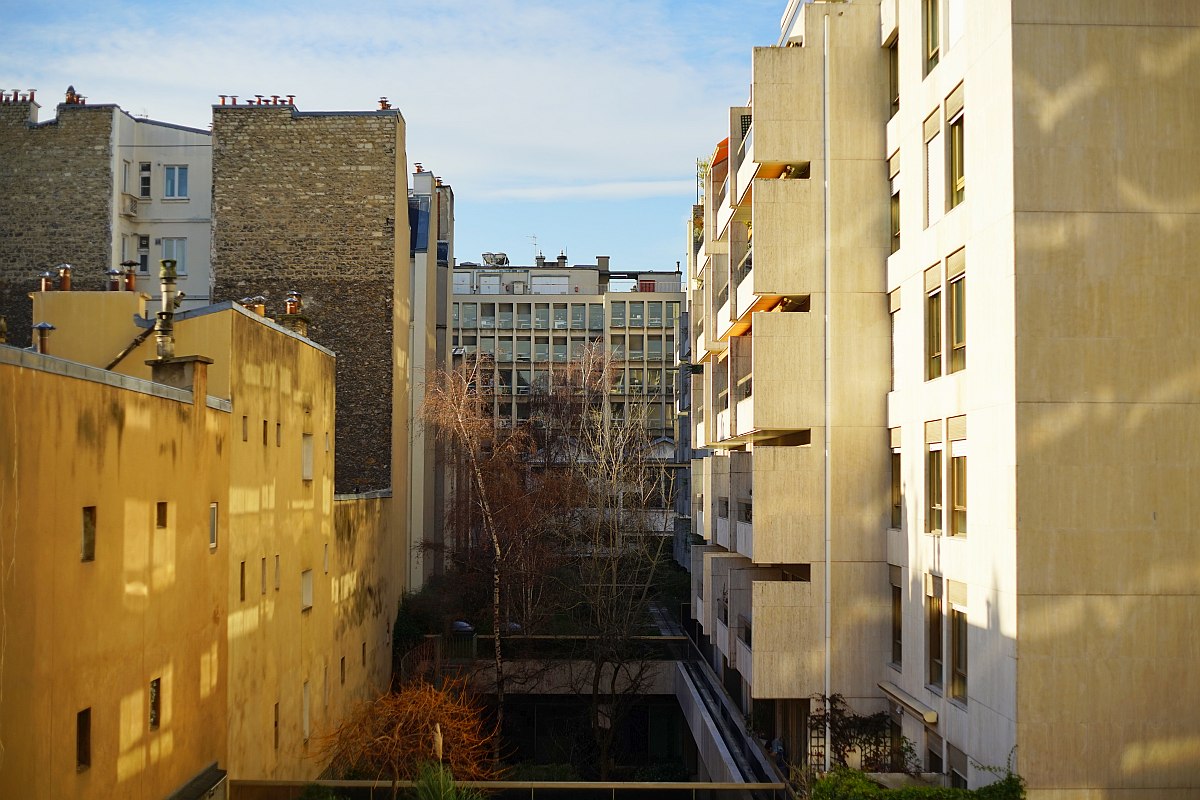
But what about a direct field comparison? I chose a dull day, having kept an idea that it gives a better occasion to see the details of lens rendition, instead of the subject niceness. I put a Rokkor-PG 1.4/50 on both A7 and Nex-5N and put the aperture at 2.8 which is good enough for this great lens for distances near to infinity.
#1 The same general test view, as above, but without the nice sun
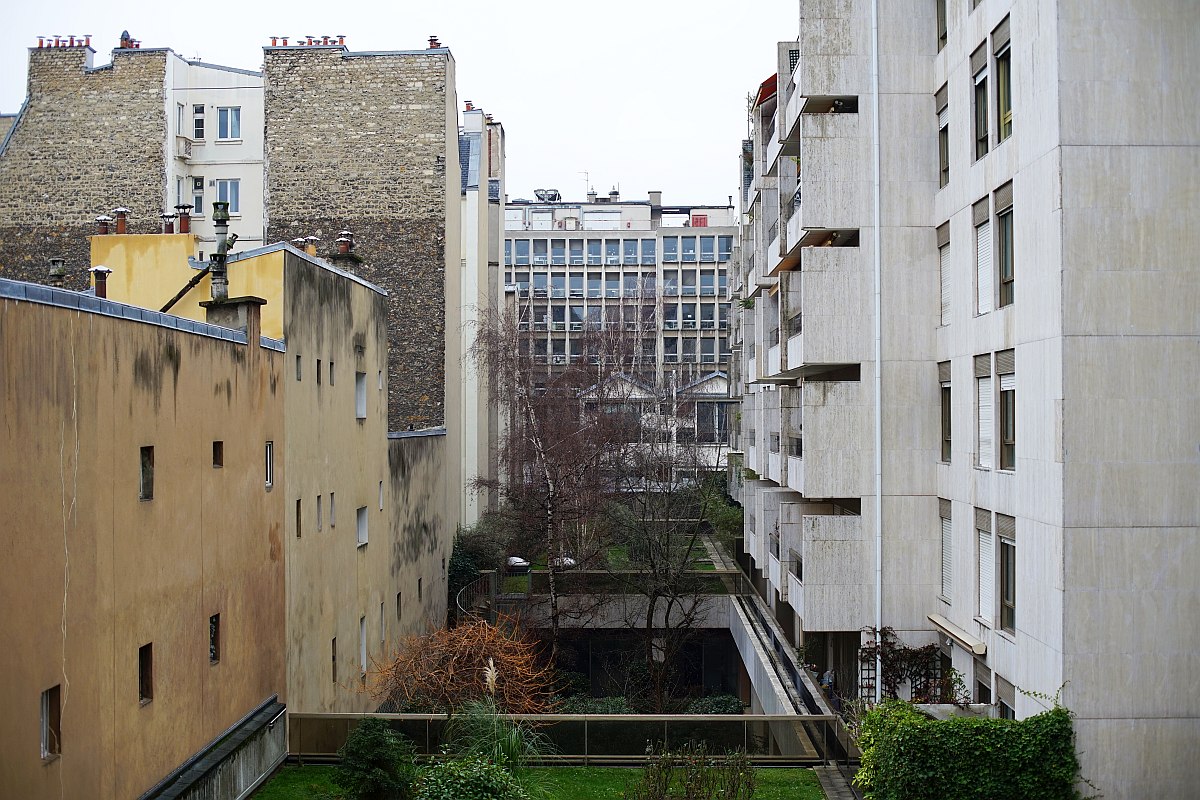
#2 A crop without processing, direct out-of-camera jpg (the NEX's size is marginally reduced to fit the same size as from FF A7)
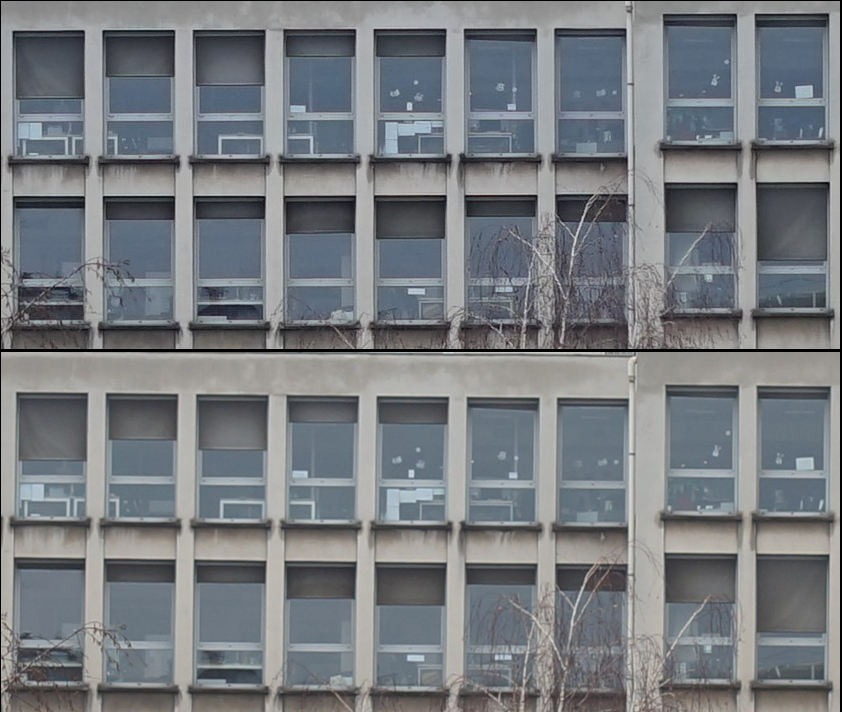
#3 A crop from another shot, focused closer in the same scene
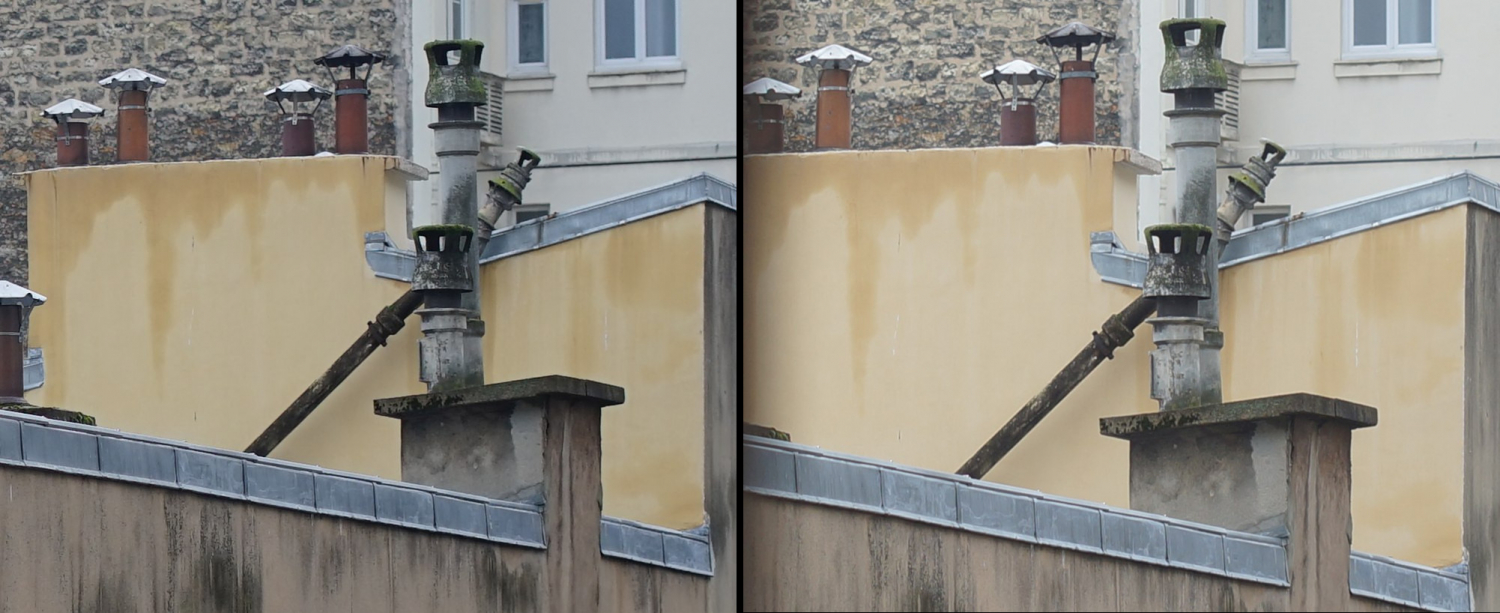
From the first sight it's easy to say that A7 renders the shapes clearer, with better colours and generally in a more "noble" manner. And this is what seduces you when you have an already impressive shot directly of the camera jpg. Even though, you see that the difference in not drastic, as for pixel peeping.
And then I tried some simple brightness/contrast tweaks in order to make Nex-5N image closer to the immediate A7 look.
#4 Here it worked in part, seen that boosting contrast for the Nex shot brings to losing details. But I exaggerated a bit with contrast
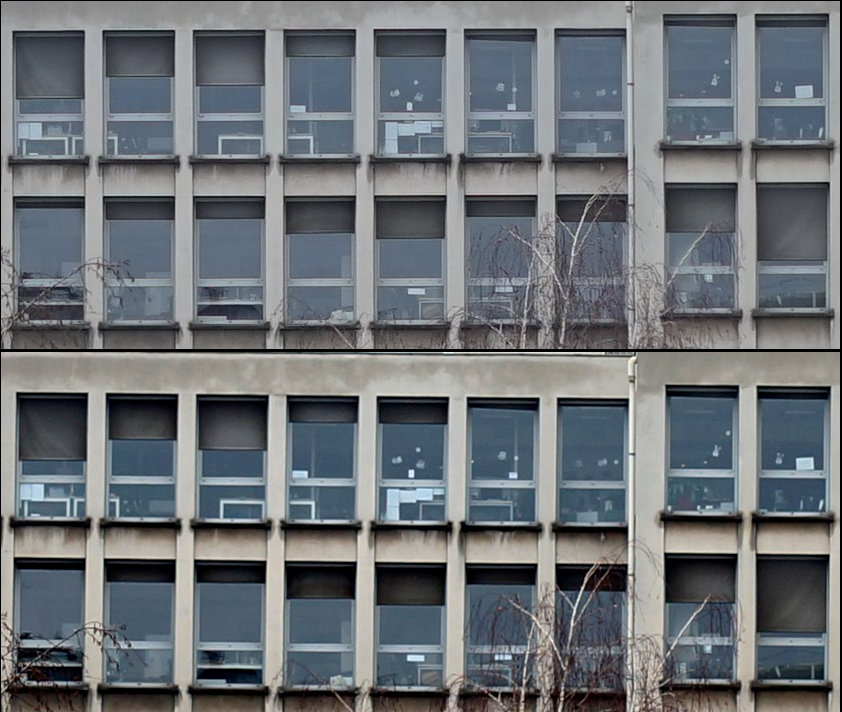
#5 But here the difference is barely noticeable, maybe the lights lose the info faster

One can easily imagine that tweaking the entire image, you may dissimulate the difference even easier.
Conclusion: I really love the older A7 renders the visible world. It's also a pleasure to lift up ISO to 1600-3200 to discover that the detail lost is not that dramatic. I love colours and shapes it renders. Saying that, I would not make it a fetish in front of the much older Nex-5N which does not need to be fetished, as it is already one! |
|
| Back to top |
|
 |
calvin83


Joined: 12 Apr 2009
Posts: 7584
Location: Hong Kong
|
 Posted: Sun Jan 20, 2019 3:30 pm Post subject: Posted: Sun Jan 20, 2019 3:30 pm Post subject: |
 |
|
calvin83 wrote:
I feel the same at the time when i upgrade my 5n to a7. You will find there will be significant boost when you upgrade to a7r2/3. 
_________________
The best lens is the one you have with you.
https://lensfever.com/
https://www.instagram.com/_lens_fever/ |
|
| Back to top |
|
 |
alex ph

Joined: 16 Mar 2013
Posts: 1674
|
 Posted: Sun Jan 20, 2019 9:14 pm Post subject: Posted: Sun Jan 20, 2019 9:14 pm Post subject: |
 |
|
alex ph wrote:
Well, I should wait for a while, for the newer models got older and the prices shift down.
Meanwhile, I found only this opinion from 2014 about how A7 compares to Nex. And it's pretty close to ours saying that with an A7 "you'll get more micro-contrast, separation, sharpness ... Often, this may not be noticeable". To my surprise, there is no much of illustrated comparisons, while the question is obviously common and was even more relevant when Sony FF cameras only came to the market.
I am very curious about how the younger Sony A7 cameras are better compared to the Nex series.
Calvin, I am pretty sure you have a demonstration of that. Could you show a side by side shot of the same scenery with the same lens? |
|
| Back to top |
|
 |
stevemark

Joined: 29 Apr 2011
Posts: 4087
Location: Switzerland
|
 Posted: Sun Jan 20, 2019 11:12 pm Post subject: Posted: Sun Jan 20, 2019 11:12 pm Post subject: |
 |
|
stevemark wrote:
| alex ph wrote: |
...
I am very curious about how the younger Sony A7 cameras are better compared to the Nex series.
Calvin, I am pretty sure you have a demonstration of that. Could you show a side by side shot of the same scenery with the same lens? |
Here's a 100% crop from the center of the JPGs out of A7 (left) and A7RII (right).
Lens: Minolta MD 2.8/35mm @ f2.8 (!).

Even if you re-size the original A7RII JPG to 24MP, the difference is clearly visible:
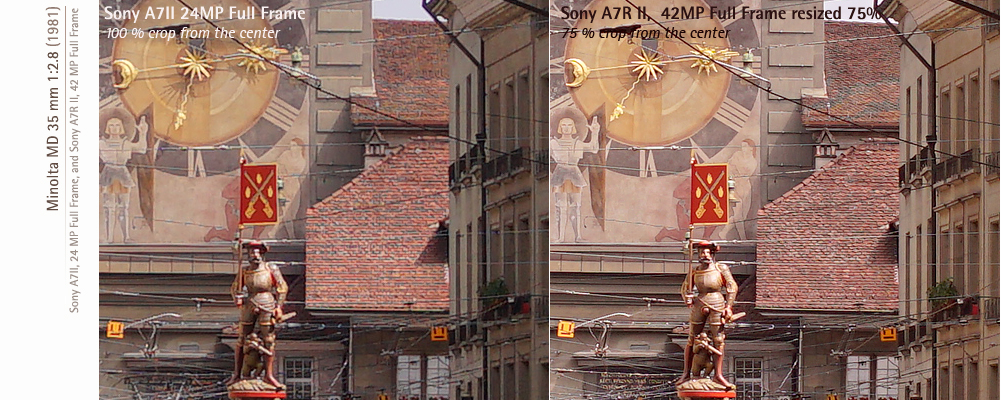
Finally, it is obvious that the useful aperture range on the A7 is much broader than on the A7RII - best results require 1) very good lenses and 2) optimal aperture (usually f4 ... f : :

_________________
www.artaphot.ch |
|
| Back to top |
|
 |
memetph

Joined: 01 Dec 2013
Posts: 940
Location: Poland
|
 Posted: Mon Jan 21, 2019 4:44 am Post subject: Posted: Mon Jan 21, 2019 4:44 am Post subject: |
 |
|
memetph wrote:
alex ph,
the resolution of the Nex5N (16mpx on APS-C) is the equivalent of 38 Mpx FF. I understand that you used the same lens from the same distance and showed the same image . What do you expect ?
I made the same comparison with a modern performing lens between an A7 and an A5000/6000. The APS-C cameras were showing more details .
In your examples , I understand that the Rokkor at f2.8 does not take advantage of the higher resolution of the Nex. |
|
| Back to top |
|
 |
Antoine

Joined: 08 Jan 2016
Posts: 298
Location: London
|
 Posted: Mon Jan 21, 2019 9:41 am Post subject: Posted: Mon Jan 21, 2019 9:41 am Post subject: |
 |
|
Antoine wrote:
Stephan,
"Finally, it is obvious that the useful aperture range on the A7 is much broader than on the A7RII - best results require 1) very good lenses and 2) optimal..."
Yes, I had already seen this review on your website which led me to buy a brand new A7rii (the collapse in price helped) rather than a A7ii. (actually Thomas B advised me on this purchase...many thanks)
Trying to make sure I understand: do you mean that the range of aperture which can be used on the A7ii is wider than the range of aperture that can be used on the A7rii? And the explanation would be with A7rii imperfections of the lens become more apparent?
Also, I am not sure I undertsand why the 100% crop on A7ii is a larger angle than the 100% crop A7rii. What is the definition of 100% crop? (apologies ofr my ignorance...)
Generally speaking, do you think the Minolta MD legacy lenses do justice to the A7rii high resolution? If limited, what are the main drawbacks?
_________________
Antoine
Sony A6000 APS-C and Sony A7 Rii
Minolta Fisheye MD Rokkor 7.5 mm f4, Fisheye MD 16 f2.8 MD R 17mm f4, MD R 20mm f2.8, MC VFC & MDIII 24mm f2.8, MD 28mm f2.0 &3.5, MD II 35mm 1.8, MD 45mm f2.0, MD 50mm f 1.2 & MD I f1.4, MC PG 58mm 1.2, MD 85mm f2.0, MD R 85mm f2.8 Varisoft, MC 85mm f1.7 MD R 100mm f2.5, MD R 100mm f4.0 macro, MD III 135mm f2.8, MD R 200mm f2.8 & 4.0, RF 250mm f5.6, MD 300mm f4.5, MD APO 400 mm f5.6, RF 500mm f8.0, RF 800mm f8.0 *2 300-s and 300-l
100 mm f4 macro bellows (5/4)
Vivitar 17mm f3.5, Elicar 300mm mirror f5.6, Zhongi turbo ii
Sigma 16mm f 2.8 fish eye
Zooms:24-50 mm f4, 35-70 mm f3.5 macro, 28-85mm f3.5-4.5, 50-135 f 3.5, 70-210 f4 and MD APO 100-500 mm f8 |
|
| Back to top |
|
 |
sergun

Joined: 01 Jun 2017
Posts: 291
Location: наша раша
|
 Posted: Mon Jan 21, 2019 12:13 pm Post subject: Posted: Mon Jan 21, 2019 12:13 pm Post subject: |
 |
|
sergun wrote:
[quote="stevemark"]
| alex ph wrote: |
Finally, it is obvious that the useful aperture range on the A7 is much broader than on the A7RII - best results require 1) very good lenses and 2) optimal aperture (usually f4 ... f |
Ha, perhaps would argue) I have was this MD-III 35/2.8 and gave a very good feeling on A7R, but after buying A7R2 clearly saw a drop in sharpness on one side. Although these cameras, the difference is not so great.
p/s It was easy for me to part with MD because there is a Loxia 35.
_________________
https://www.flickr.com/photos/105161078@N06/
https://fotoload.ru/fotosets/6661/ |
|
| Back to top |
|
 |
stevemark

Joined: 29 Apr 2011
Posts: 4087
Location: Switzerland
|
 Posted: Mon Jan 21, 2019 12:49 pm Post subject: Posted: Mon Jan 21, 2019 12:49 pm Post subject: |
 |
|
stevemark wrote:
| sergun wrote: |
| ... I have was this MD-III 35/2.8 and gave a very good feeling on A7R, but after buying A7R2 clearly saw a drop in sharpness on one side. |
Strange - the resolution difference (36MP vs 43MP) is really small, the linear resolution difference is just about 9% ...
I have seen similar problems though on my A7 cameras because of the wobbling bayonet ...
_________________
www.artaphot.ch |
|
| Back to top |
|
 |
tb_a


Joined: 26 Jan 2010
Posts: 3678
Location: Austria
Expire: 2019-08-28
|
 Posted: Mon Jan 21, 2019 1:58 pm Post subject: Posted: Mon Jan 21, 2019 1:58 pm Post subject: |
 |
|
tb_a wrote:
| Antoine wrote: |
| Generally speaking, do you think the Minolta MD legacy lenses do justice to the A7rii high resolution? If limited, what are the main drawbacks? |
Maybe you can use Google translate for this: http://artaphot.ch/minolta-sr/objektiv-vergleiche/434-sony-a7rii-and-summilux-1-4-35mm-asph-sony-zeiss-fe-2-8-35mm-and-minolta-md-2-8-35mm
Bottomline: The MD 35mm/F2.8 is outresolving the 42MP sensor; i.e. would even be good enough for higher resolution sensors (not yet available) and the modern "Zeiss" variant isn't any better.
_________________
Thomas Bernardy
Manual focus lenses mainly from Minolta, Pentax, Voigtlaender, Leitz, Topcon and from Russia (too many to be listed here). |
|
| Back to top |
|
 |
Antoine

Joined: 08 Jan 2016
Posts: 298
Location: London
|
 Posted: Mon Jan 21, 2019 3:03 pm Post subject: Posted: Mon Jan 21, 2019 3:03 pm Post subject: |
 |
|
Antoine wrote:
Hi Thomas
Thanks I did indeed google translate some time ago (despite learning it from 11 to 18, my German is very poor) but my questions this time are about the whole range and also specific about Stephan comments (maybe my English is not good enough either...).
Generally speaking, my first contact with A7Rii is a big step up on A 6000... let alone to get some real wide angle pictures without having to use the (good enough) Zhongi converter and Techart seems to work fine... for now.
Just a pity nobody issued an improved Techart also useful for Teleobjectives... It is actually a productivity improvement as you would need only one motor for as many lenses as one wishes.
_________________
Antoine
Sony A6000 APS-C and Sony A7 Rii
Minolta Fisheye MD Rokkor 7.5 mm f4, Fisheye MD 16 f2.8 MD R 17mm f4, MD R 20mm f2.8, MC VFC & MDIII 24mm f2.8, MD 28mm f2.0 &3.5, MD II 35mm 1.8, MD 45mm f2.0, MD 50mm f 1.2 & MD I f1.4, MC PG 58mm 1.2, MD 85mm f2.0, MD R 85mm f2.8 Varisoft, MC 85mm f1.7 MD R 100mm f2.5, MD R 100mm f4.0 macro, MD III 135mm f2.8, MD R 200mm f2.8 & 4.0, RF 250mm f5.6, MD 300mm f4.5, MD APO 400 mm f5.6, RF 500mm f8.0, RF 800mm f8.0 *2 300-s and 300-l
100 mm f4 macro bellows (5/4)
Vivitar 17mm f3.5, Elicar 300mm mirror f5.6, Zhongi turbo ii
Sigma 16mm f 2.8 fish eye
Zooms:24-50 mm f4, 35-70 mm f3.5 macro, 28-85mm f3.5-4.5, 50-135 f 3.5, 70-210 f4 and MD APO 100-500 mm f8 |
|
| Back to top |
|
 |
memetph

Joined: 01 Dec 2013
Posts: 940
Location: Poland
|
 Posted: Mon Jan 21, 2019 4:23 pm Post subject: Posted: Mon Jan 21, 2019 4:23 pm Post subject: |
 |
|
memetph wrote:
| tb_a wrote: |
[quote="Antoine]
Bottomline: The MD 35mm/F2.8 is outresolving the 42MP sensor; i.e. would even be good enough for higher resolution sensors (not yet available) and the modern "Zeiss" variant isn't any better. |
Having both lenses I would not say that. The Sony Zeiss has typical flaws from modern ML lenses (strong vignetting).
In my opinion it is better than the Minolta showing better clarity and a good performance across the frame from wide open .
Its bokeh at f2.8 is also very smooth . |
|
| Back to top |
|
 |
tb_a


Joined: 26 Jan 2010
Posts: 3678
Location: Austria
Expire: 2019-08-28
|
 Posted: Mon Jan 21, 2019 5:52 pm Post subject: Posted: Mon Jan 21, 2019 5:52 pm Post subject: |
 |
|
tb_a wrote:
| Antoine wrote: |
Thanks I did indeed google translate some time ago (despite learning it from 11 to 18, my German is very poor) but my questions this time are about the whole range and also specific about Stephan comments (maybe my English is not good enough either...).
Generally speaking, my first contact with A7Rii is a big step up on A 6000... let alone to get some real wide angle pictures without having to use the (good enough) Zhongi converter and Techart seems to work fine... for now.
Just a pity nobody issued an improved Techart also useful for Teleobjectives... It is actually a productivity improvement as you would need only one motor for as many lenses as one wishes. |
Having also quite many Minolta MD lenses I can tell you that they all work fine with the A7R II. I'm shure that your very nice collection will shine on your new camera as well.
BTW, I'm using some heavy tele lenses on Techart as well. Sometimes you have just to do some manual pre-focusing and you have to hold the lens as well to avoid possible damage of the AF-adapter.
_________________
Thomas Bernardy
Manual focus lenses mainly from Minolta, Pentax, Voigtlaender, Leitz, Topcon and from Russia (too many to be listed here). |
|
| Back to top |
|
 |
alex ph

Joined: 16 Mar 2013
Posts: 1674
|
 Posted: Mon Jan 21, 2019 8:32 pm Post subject: Posted: Mon Jan 21, 2019 8:32 pm Post subject: |
 |
|
alex ph wrote:
Thank you, Steven, for broadening the range of comparison. Would it be correct to conclude that, sharing the same type of sensor, Nex-5N, A7, A7R and A7RII mainly differ in the level of detalization?
Memetph, your assumption on better details of an Sony APS-C as compared with an FF sounds quite paradoxical. The great advantage of this forum, and it specialty as for many others, is that we put forward shots to illustrate the idea. As long as you have side-by-side shots from an A7 and an A5000, that'll be really important to see them. That will perfectly match the core of this topic!
Folks, please share some of your shots showing the comparative difference between Alphas and Nexes of different generations. |
|
| Back to top |
|
 |
tb_a


Joined: 26 Jan 2010
Posts: 3678
Location: Austria
Expire: 2019-08-28
|
 Posted: Mon Jan 21, 2019 10:08 pm Post subject: Posted: Mon Jan 21, 2019 10:08 pm Post subject: |
 |
|
tb_a wrote:
| alex ph wrote: |
Thank you, Steven, for broadening the range of comparison. Would it be correct to conclude that, sharing the same type of sensor, Nex-5N, A7, A7R and A7RII mainly differ in the level of detalization?
Memetph, your assumption on better details of an Sony APS-C as compared with an FF sounds quite paradoxical. The great advantage of this forum, and it specialty as for many others, is that we put forward shots to illustrate the idea. As long as you have side-by-side shots from an A7 and an A5000, that'll be really important to see them. That will perfectly match the core of this topic!
Folks, please share some of your shots showing the comparative difference between Alphas and Nexes of different generations. |
Sorry, but IMHO really meaningful comparisons can only be done when shooting uncompressed RAW in the native ISO of the sensor and converted into JPG with exactly the same algorithm afterwards on PC.
I have 8 digital system cameras with different sensor sizes from MFT up to high resolution FF where I can use and compare legacy lenses but I don't use the camera's engines to produce my JPG's. As a general observation I can say that cameras with AA-filtering appear less "sharp" with lesser details in pixel peeping mode compared to cameras without AA-filter; independent of sensor size.
_________________
Thomas Bernardy
Manual focus lenses mainly from Minolta, Pentax, Voigtlaender, Leitz, Topcon and from Russia (too many to be listed here). |
|
| Back to top |
|
 |
alex ph

Joined: 16 Mar 2013
Posts: 1674
|
 Posted: Mon Jan 21, 2019 10:51 pm Post subject: Posted: Mon Jan 21, 2019 10:51 pm Post subject: |
 |
|
alex ph wrote:
Technically, your remark must be very precise. Looking at the results I posted above I was asking myself if the even bigger difference is not caused by the jpg algorythm, other than by the sensors difference.
Still, we normally use the cameras for real world shooting, so the general (and subjectively coloured) impression of the shots is something that plays its primary role. And as long as I personally use jpg in order not to mess myself with much longer procession of raws, such a comparison still makes sens for me. |
|
| Back to top |
|
 |
aidaho


Joined: 29 Apr 2018
Posts: 456
Location: Ukraine
|
 Posted: Tue Jan 22, 2019 3:44 pm Post subject: Posted: Tue Jan 22, 2019 3:44 pm Post subject: |
 |
|
aidaho wrote:
While everything said about FF vs crop at the close up level is true, nowadays for MF users the choice isn't that obvious.
I've spent last year shooting with Sony NEX-3N with Lens Turbo II and recently upgraded to A7R.
While, again, there is no contest once you go pixel-peeping, focal reducers do close the gap by a lot.
Original FOV and rendering for adapted MF FF lenses is now a reality on APS-C. And that counts for around 80% of "being there".
Considering how FF mirrorless bodies abandoned their claim to fame as lightweight FF, I can envision a possible reverse exodus to APS-C in the future.
And having commercially available focal reducers to back me up, this wouldn't be nearly as dramatic downgrade as it might have been otherwise. |
|
| Back to top |
|
 |
Antoine

Joined: 08 Jan 2016
Posts: 298
Location: London
|
 Posted: Tue Jan 22, 2019 4:28 pm Post subject: Posted: Tue Jan 22, 2019 4:28 pm Post subject: |
 |
|
Antoine wrote:
Adaho. Not quite, you are missing something.
You cannot use both focal reducer AND Techart AF. It is one or the other.
All my lenses (except the initial Sony a6000 16-50mm zoom) are manual focus lenses. A7rii solves the issue. I get the real focal length and the AF function... and my bag with 3 MF lenses is much lighter than with 2 AF lenses as I only have one focusing engine.
_________________
Antoine
Sony A6000 APS-C and Sony A7 Rii
Minolta Fisheye MD Rokkor 7.5 mm f4, Fisheye MD 16 f2.8 MD R 17mm f4, MD R 20mm f2.8, MC VFC & MDIII 24mm f2.8, MD 28mm f2.0 &3.5, MD II 35mm 1.8, MD 45mm f2.0, MD 50mm f 1.2 & MD I f1.4, MC PG 58mm 1.2, MD 85mm f2.0, MD R 85mm f2.8 Varisoft, MC 85mm f1.7 MD R 100mm f2.5, MD R 100mm f4.0 macro, MD III 135mm f2.8, MD R 200mm f2.8 & 4.0, RF 250mm f5.6, MD 300mm f4.5, MD APO 400 mm f5.6, RF 500mm f8.0, RF 800mm f8.0 *2 300-s and 300-l
100 mm f4 macro bellows (5/4)
Vivitar 17mm f3.5, Elicar 300mm mirror f5.6, Zhongi turbo ii
Sigma 16mm f 2.8 fish eye
Zooms:24-50 mm f4, 35-70 mm f3.5 macro, 28-85mm f3.5-4.5, 50-135 f 3.5, 70-210 f4 and MD APO 100-500 mm f8 |
|
| Back to top |
|
 |
aidaho


Joined: 29 Apr 2018
Posts: 456
Location: Ukraine
|
 Posted: Tue Jan 22, 2019 4:36 pm Post subject: Posted: Tue Jan 22, 2019 4:36 pm Post subject: |
 |
|
aidaho wrote:
| Antoine wrote: |
Adaho. Not quite, you are missing something.
You cannot use both focal reducer AND Techart AF. It is one or the other.
All my lenses (except the initial Sony a6000 16-50mm zoom) are manual focus lenses. A7rii solves the issue. I get the real focal length and the AF function... and my bag with 3 MF lenses is much lighter than with 2 AF lenses as I only have one focusing engine. |
I also have useful things to put between lens and body, like macro-helicoids or tilt adapter, which cannot be used with focal reducer.
This does not change my overall assesment. I just choose not to percieve limitations as a deal breakers, but rather work around or accept those I can't avoid. |
|
| Back to top |
|
 |
memetph

Joined: 01 Dec 2013
Posts: 940
Location: Poland
|
 Posted: Tue Jan 22, 2019 7:20 pm Post subject: Posted: Tue Jan 22, 2019 7:20 pm Post subject: |
 |
|
memetph wrote:
| alex ph wrote: |
Thank you, Steven, for broadening the range of comparison. Would it be correct to conclude that, sharing the same type of sensor, Nex-5N, A7, A7R and A7RII mainly differ in the level of detalization?
Memetph, your assumption on better details of an Sony APS-C as compared with an FF sounds quite paradoxical. The great advantage of this forum, and it specialty as for many others, is that we put forward shots to illustrate the idea. As long as you have side-by-side shots from an A7 and an A5000, that'll be really important to see them. That will perfectly match the core of this topic!
Folks, please share some of your shots showing the comparative difference between Alphas and Nexes of different generations. |
It is not paradoxal.
Sony A7 cropped in APS-C = 10 Mpx
Nex 5n : 16 Mpx
A5000 : 20 Mpx
A6000 : 24 Mpx
In order to get more details from a FF sensor than from a APS-C you need to use their full surfaces or cropp them in the same proportion.
On your pictures , using the same lens from the same distance , you are cropping 1.5 times more the FF picture. |
|
| Back to top |
|
 |
Lightshow


Joined: 04 Nov 2011
Posts: 3666
Location: Calgary
|
 Posted: Tue Jan 22, 2019 8:59 pm Post subject: Posted: Tue Jan 22, 2019 8:59 pm Post subject: |
 |
|
Lightshow wrote:
| aidaho wrote: |
While everything said about FF vs crop at the close up level is true, nowadays for MF users the choice isn't that obvious.
I've spent last year shooting with Sony NEX-3N with Lens Turbo II and recently upgraded to A7R.
While, again, there is no contest once you go pixel-peeping, focal reducers do close the gap by a lot.
Original FOV and rendering for adapted MF FF lenses is now a reality on APS-C. And that counts for around 80% of "being there".
Considering how FF mirrorless bodies abandoned their claim to fame as lightweight FF, I can envision a possible reverse exodus to APS-C in the future.
And having commercially available focal reducers to back me up, this wouldn't be nearly as dramatic downgrade as it might have been otherwise. |
Focal reducers are only really viable if you only have 1 or 2 mounts to adapt, but I have many to adapt, it makes far more sense to go FF in my case.
As much as I love my NEX-7, I find it hard to go back to crop after using my A7r, that sensor is wonderful(though it is a bit too sensitive to ray angles).
In my experience, more resolution just captures in finer detail what the lens projects, so if it's a great lens, you get great pictures, it may be diminishing returns at some point, but that won't diminish what the lens can do.
I think most of my lenses should be good up to 75MP before the lenses restrict resolution, and a few should be good to 100MP.
_________________
A Manual Focus Junky...
One photographers junk lens is an artists favorite tool.
My lens list
http://www.flickr.com/photos/lightshow-photography/ |
|
| Back to top |
|
 |
alex ph

Joined: 16 Mar 2013
Posts: 1674
|
 Posted: Thu Jan 24, 2019 10:09 pm Post subject: Posted: Thu Jan 24, 2019 10:09 pm Post subject: |
 |
|
alex ph wrote:
Aidaho, agreed with your reasoning. I did not make a comparison for the sake of some nostalgic "good-bye" to the NEX. On the contrary, I was asking myself in which situations it worth bringing with me a bulkier and more visible Alpha, and where the Nex still provides a clearly good service as compared to that.
Memetph, still did not get your point about the same lens and possibly better results with an A6000. Could you just post two shots?
Here is the unprocesed and unevened crop from the both cameras. The upper is A7 and the lower is Nex-5N.

The black zone is the real world difference due to the crop factor. And the length of the two original crops differs only 1.25 times and not 1.5 or more. That means A7's sensor resolves better and not worse or the same as compared to the Nex's one.
Cheers |
|
| Back to top |
|
 |
memetph

Joined: 01 Dec 2013
Posts: 940
Location: Poland
|
 Posted: Fri Jan 25, 2019 6:44 am Post subject: Posted: Fri Jan 25, 2019 6:44 am Post subject: |
 |
|
memetph wrote:
| alex ph wrote: |
Memetph, still did not get your point about the same lens and possibly better results with an A6000. Could you just post two shots?
Cheers |
I just say : if you take a picture with a good lens from the same distance with an Nex 5n and an A7 and then crop by 1.5 the A7 capture in order to have comparable images , then the level of details should be better with the Nex5n.
Why ? because the resolution of the Nex5n is higher , 16Mpx vs 10Mpx for the cropped A7.
If it is not the case , it means that your lens has more or less reached its limit.
I added that , not only is it logical but I tested it with an A5000 and A6000 with a good lens ( Sony FE 70/200) . It was noticable and I bought the A6000 . This lens is a better 105/300mm equivalent with on an A6000 than on a cropped A7. |
|
| Back to top |
|
 |
tb_a


Joined: 26 Jan 2010
Posts: 3678
Location: Austria
Expire: 2019-08-28
|
 Posted: Fri Jan 25, 2019 1:02 pm Post subject: Posted: Fri Jan 25, 2019 1:02 pm Post subject: |
 |
|
tb_a wrote:
Out of curiosity I've compared pictures taken with both my NEX 16MP APS-C and my A7R II in 18MP APS-C mode taken with my best lens.
For a 100% fair comparison I've resized both pictures to max. 3800px on the long size to view them on my 32" 4K UHD monitor full screen. That would equal a final print out in the size of apprx. 70 x 47 cm.
If watched very closely the slightly better detail is visible in the A7R II pictures because there is no AA-filtering.
However, nobody would watch at a picture in that size from 10 cm viewing distance in real life.
If watched on a normal 24" HD screen resized to 2000px in 100% viewing mode (picture size apprx. 50 x 33 cm) you won't be able to spot any difference.
Verdict: In terms of picture quality on the final uncropped output any old APS-C camera such as my old NEX-C3 (16MP) will most probably beat even the newest A7 III in crop mode (10MP). The question is whether it will be visible under normal viewing circumstances at all. Most probably not.
Actually that was the reason why I invested in a new large high resolution screen (Eizo EV3237) when I acquired my A7R II as otherwise any advantage of the new high resolution camera would only be visible on large print-outs and not on screen.
Conclusion: If you're watching your pictures on a normal HD screen only most probably any smartphone will be good enough (apart from other limitations). 
Edit: I've included pictures from my Ricoh GXR-M 12MP APS-C camera (without AA-filtering) in my comparison and it beats the filtered NEX 16MP camera as well. Actually it's better than any 24MP A7.
_________________
Thomas Bernardy
Manual focus lenses mainly from Minolta, Pentax, Voigtlaender, Leitz, Topcon and from Russia (too many to be listed here). |
|
| Back to top |
|
 |
aidaho


Joined: 29 Apr 2018
Posts: 456
Location: Ukraine
|
 Posted: Fri Jan 25, 2019 4:00 pm Post subject: Posted: Fri Jan 25, 2019 4:00 pm Post subject: |
 |
|
aidaho wrote:
| tb_a wrote: |
| However, nobody would watch at a picture in that size |
I surely do watch both mine and other people pictures in 1:1.
In fact I often subscribe to people who are shooting with interesting glass and provide full-size original image.
There is simply no better way to evaluate a lens than to pixel-peep at full resolution.
People often antagonise pixel peeping as some sort of arch enemy of the good photography.
I don't subscribe to the opinion of these things being at odds, you can have them both.
To pick up an interesting thing and move it closer to our eyes is a natural urge, I feel no shame in doing so with interesting photos.
And don't get me started on those 2000px landscapes, in a digital age of free infinite magnification those are infuriating.
Getting back on track: at 100% magnification there is no contest, as shown above. Won't make up for a bad photo, but will make a good one even better.
And if we are to size down and pull a print card, why stop there? Lets print postcards, postage stamps even, to make pretty much any camera look like silly overkill. |
|
| Back to top |
|
 |
tb_a


Joined: 26 Jan 2010
Posts: 3678
Location: Austria
Expire: 2019-08-28
|
 Posted: Fri Jan 25, 2019 6:28 pm Post subject: Posted: Fri Jan 25, 2019 6:28 pm Post subject: |
 |
|
tb_a wrote:
| aidaho wrote: |
| tb_a wrote: |
| However, nobody would watch at a picture in that size |
I surely do watch both mine and other people pictures in 1:1.
In fact I often subscribe to people who are shooting with interesting glass and provide full-size original image.
There is simply no better way to evaluate a lens than to pixel-peep at full resolution.
People often antagonise pixel peeping as some sort of arch enemy of the good photography.
I don't subscribe to the opinion of these things being at odds, you can have them both.
To pick up an interesting thing and move it closer to our eyes is a natural urge, I feel no shame in doing so with interesting photos.
And don't get me started on those 2000px landscapes, in a digital age of free infinite magnification those are infuriating.
Getting back on track: at 100% magnification there is no contest, as shown above. Won't make up for a bad photo, but will make a good one even better.
And if we are to size down and pull a print card, why stop there? Lets print postcards, postage stamps even, to make pretty much any camera look like silly overkill. |
IMHO we are talking about a different subjects here.
My findings are that if you compare different sensors with the same lens you have to search for the differences on a UHD screen at 100% magnification (or alternatively print in a similar size) in order to spot any difference as you won't be able to distuingish them on a normal HD screen.
You are talking about the comparison of different lenses here and these differences are more likely to be seen, even on normal HD screens, although you would see every single monitor pixel at 10 cm viewing distance which makes it quite difficult.
It goes without saying that you have better cropping possibilities with high resolution sensors, but that is again another subject.
Coming back to the OP's topic: The sensor size is the least important factor for the final image quality if pictures are taken with good quality lenses at low ISO settings.
I've already made the test and compared pictures from my smartphone (Sony 24MP sensor) with pictures from my Sony A850 FF 24MP camera in good light conditions with similar angle of view and NOBODY was able to spot any difference in the final picture presented on screen.
_________________
Thomas Bernardy
Manual focus lenses mainly from Minolta, Pentax, Voigtlaender, Leitz, Topcon and from Russia (too many to be listed here). |
|
| Back to top |
|
 |
|
|
